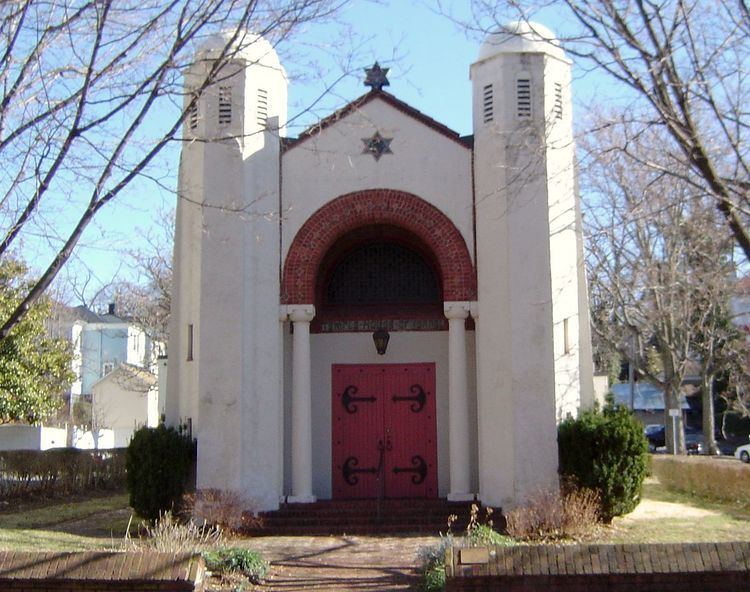Status Active Website www.thoi.org Opened 1925 Affiliation Reform Judaism | Leadership Rabbi: Joe Blair Completed 1925 Phone +1 925-272-8563 | |
 | ||
Location 15 North Market Street,
Staunton, Virginia,
United States Address 15 N Market St, Staunton, VA 24401, USA Architectural style Moorish Revival architecture Similar Trinity Episcopal Church, Blue Ridge Mountains, Woodrow Wilson President, Frontier Culture Museum, Gypsy Hill Park | ||
Temple House of Israel is a Jewish congregation in Staunton, Virginia, United States. Founded in 1876 by Major Alexander Hart, it originally held services in members' homes, then moved to a building on Kalorama street in 1885, the year it joined the Union for Reform Judaism.
Contents
In 1925 the congregation constructed its current building at 115 North Market street, a contributing property to the Gospel Hill historic district. The Moorish Revival structure was designed by Sam Collins of T.J. Collins and son, and includes Mercer tiles, and windows and a glass screen by Charles Connick of Boston.
House of Israel's sister congregation is Beth El Congregation of Harrisonburg, Virginia. As of 2010, Joe Blair served as rabbi for both synagogues.
Early history
Temple House of Israel was founded in 1876 in Staunton, Virginia, United States by Major Alexander Hart, who had fought for the Confederate States of America in the American Civil War. Hart served as the congregation's president and minister until at least 1893.
Services were held in members' homes for more than eight years. In 1884 the congregation acquired the Hoover School building at 200 Kalorama Street, at the corner of Market Street, and in February 1885 began holding services there. The building still stands, diagonally opposite the Stonewall Jackson Hotel. That same year the synagogue joined the Union of American Hebrew Congregations (now the Union for Reform Judaism).
The congregation purchased land north of Staunton for a cemetery in 1886, and held its first burial there in 1887. The cemetery, on North Augusta Street between Woodland Drive and Lee Street, is still used for burials today.
At the turn of the 20th century, House of Israel had no rabbi, but held services twice a week, Friday nights from 8:00 to 9:00pm, and Saturday from 10:30 to 11:30am. The congregation also ran a religious school. By 1907 Staunton's Jewish population was an estimated 40 people. House of Israel had fifteen member families, and still held services twice a week. However, the congregation still had no rabbi, and the religious school no longer functioned.
Fannie Barth Strauss, instructor and later Assistant Professor of Latin and German at Mary Baldwin College from 1918 to 1954, re-established the Hebrew school at House of Israel in 1916. In 1919, though the synagogue still had no rabbi, the school held classes once a week, and had two teachers and twelve students. Strauss would serve as the school's principal from its re-establishment until at least 1964, and also served as the synagogues Treasurer from 1946 until at least 1964.
Move to Market street
By 1925 the congregation had outgrown its Kalorama Street building, and it purchased a lot at 115 North Market street from Mary Baldwin College. Sam Collins of T.J. Collins and son designed a new Moorish Revival building there. The one-story stucco building had a twin gable roof with 3 bays. Decorated with "Early Assyrian motifs", the facade presented "[f]lanking twin towers with suppressed buttresses", and a "[l]arge arched opening in [the] central bay, supported by unusual columns", and included Mercer tiles. All the windows, and a glass screen, were created by Charles Connick of Boston, who also created famous windows for a number of religious buildings, including the rose windows of St. Patrick's Cathedral and the Cathedral of Saint John the Divine in New York City. The building was a contributing property to the successful 1984 National Register of Historic Places nomination of Gospel Hill as a historic district.
During the early 1970s, Frank M. Waldorf was the congregation's rabbi. He went on to serve for 30 years as rabbi at Temple Sinai in Brookline, Massachusetts.
1980s to present
The congregation remained small; in 1983, membership was only 28 families. Douglas D. Weber served as rabbi of both House of Israel and its sister congregation Beth El Congregation of Harrisonburg, Virginia. From 1984 to 1988 Lynne Landsberg filled that role. The 30th female rabbinic graduate of the Union for Reform Judaism, she had previously served as associate rabbi of Manhattan's Central Synagogue. She subsequently took on a number of roles at the Union for Reform Judaism, and, after a serious and disabling accident in 1999, became the senior adviser on disability issues at the Religious Action Center for Reform Judaism. From 1988 - 1992, Rabbi Dan Fink and Rabbi Laura Rappaport jointly led Temple House of Israel and Beth El Congregation of Harrisonburg. During the 1990s the two congregations were served by Jonathan Biatch as rabbi.
As of 2010, the rabbi of House of Israel and Beth El was Joe Blair; the two congregations combined had 120 member families. Blair received B.A. and Master of Computer Science degrees from the University of Virginia, and a Juris Doctor from The College of William & Mary Law School. After working in the computer field for 15 years, and briefly as a general practice attorney, he returned to school, attending the Reconstructionist Rabbinical College, from which he graduated with a Masters in Hebrew Letters in 1996. In 2004 he was appointed an adjunct professor of religion at Mary Baldwin College. A member of Toastmasters International, to which he attributes his speaking abilities, he also moderates a conversion forum on Jewish.com. In 2008 Blair was one of 18 rabbis chosen nationally to participate in the STAR (Synagogues: Transformation and Renewal) elite training program.
On film
Temple House of Israel served as a location for the documentary film Rita Dove: An American Poet produced by Heritage Film Project. Filming took place in December 2013.
